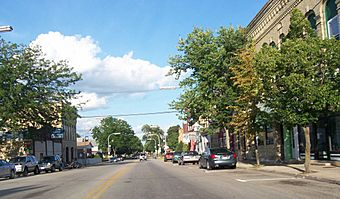Waterloo Downtown Historic District (Waterloo, Wisconsin) facts for kids
Quick facts for kids |
|
|
Waterloo Downtown Historic District
|
|

A portion of the district.
|
|
| Location | Jct. of Madison and Monroe Sts., Waterloo, Wisconsin |
|---|---|
| Area | 5.2 acres (2.1 ha) |
| NRHP reference No. | 00001360 |
| Added to NRHP | November 8, 2000 |
The Waterloo Downtown Historic District in Waterloo, Wisconsin is a special area that was added to the National Register of Historic Places in 2000. It covers about 5.2 acres, which is roughly the size of five football fields! This district is important because it helps us remember and protect the old buildings that show what downtown Waterloo looked like a long time ago.
Exploring Waterloo's Historic Downtown
The Waterloo Downtown Historic District is like a time capsule of the town's past. It includes many interesting old buildings that show different styles of architecture. These buildings tell stories about the people and businesses that shaped Waterloo.
Notable Buildings and Their Styles
- The Muebus & Fiebeger's Double Block was built in 1874. It shows off the Italianate style, which was popular back then. This style often features tall, narrow windows and decorative brackets under the roof.
- The Brandner dry goods store opened in 1885. A dry goods store sold things like fabric, clothing, and other household items.
- The Doering Block, built in 1893, is a great example of the Queen Anne style. This style is known for its fancy details, like towers, turrets, and different textures on the walls.
- In 1896, Becken's Saloon was built. Saloons were places where people could gather and socialize.
- The Failinger general store from 1897 was a place where people could buy almost anything they needed, from food to tools.
- The Community Hall, built in 1923, features Neoclassical architecture. This style looks back to ancient Greek and Roman buildings, often with grand columns and simple, balanced designs.
- The Stoke Brothers Auto Filling Station from 1924 has a Colonial Revival look. This style brings back elements from early American colonial homes, like symmetrical fronts and classic details.
- Finally, the Mode Theater from 1938 shows the Arte Moderne style. This style is sleek and modern, with smooth surfaces, rounded corners, and often horizontal lines, reflecting the excitement of the machine age.
These buildings together create a unique picture of Waterloo's history and how its downtown grew over the years.

All content from Kiddle encyclopedia articles (including the article images and facts) can be freely used under Attribution-ShareAlike license, unless stated otherwise. Cite this article:
Waterloo Downtown Historic District (Waterloo, Wisconsin) Facts for Kids. Kiddle Encyclopedia.
